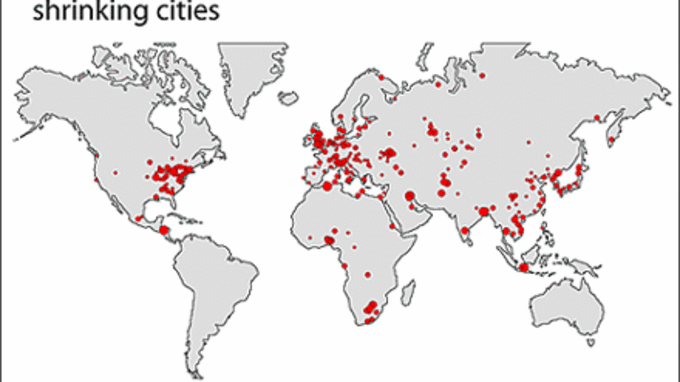Shrinking Cities

Explanations
The situation is dramatic: 1.3 million apartments in eastern Germany are untenanted. In the year 2030, the figure is expected to increase to 2 million. The unemployment rate is 20 percent. More than a million residents have left the new states of the former East Germany. Young, well-educated people in particular are turning their backs on their home regions for the West in pursuit of jobs or apprenticeships, which are currently rare even there. The prognosis is that the population of eastern Germany will be halved by 2080 - also because of demographic trends. Eastern Germany is not a unique case. Along with several shrinking regions in western Germany, all over the world there are about 400 cities with populations over 100,000 that have lastingly shrunk in the last fifty years. The population in the old industrial states is beginning to decline; the process of urbanization has reached or past its zenith; the economy is still growing slightly, but employment has steadily fallen for quite some time. It is the end of a 200-year epoch in which the industrial countries' population, economy, affluence, and cities grew almost continuously and usually rapidly.
Five years ago, the Federal Cultural Foundation initiated the "Shinking Cities" project to investigate the world-wide phenomenon of urban shrinkage. Since then the project has examined a number of cities in Germany, Great Britain, Russia and the United States and provided suggestions on how to best address the problem. More than 200 artists, architects, scholars and local interest groups have participated in "Shrinking Cities" since 2002. The results have been presented at two exhibitions and numerous events, in books and digital publications.
The exhibitions in Berlin, Halle/Saale and Leipzig were an overwhelming success. "Shrinking Cities" was among the best-attended exhibitions at all the venues. The first 5000 copies of the first book were sold within weeks.
The project not only established the term "shrinking cities" in German and international circles of discourse, but also significantly contributed to the public discussion on the issue over the past several years.
Between autumn 2006 and spring 2008, the "Shrinking Cities" project presented its global findings and recommendations concerning potential courses of action in a global context. In addition to the United States, Great Britain, Russia, Japan and Germany, the project also toured several other countries especially hard hit by massive urban shrinkage. Since the 1990s one quarter of the world's largest cities has suffered population loss, and their number is increasing. The "Shrinking Cities" project tour initiated an international dialogue about this yet unacknowledged urban phenomenon which has become - along with the high-speed urbanization processes taking place at the same time - one of the world's most important urban development issues.
The concept of the exhibition was individualized and updated for each venue. Additional activities and event programmes were also organized together with local partners.
The international stations were:
Italy, Venice, Biennale di Venezia: a contribution to the 10th International Biennial of Architecture, Venice, from September 10 to November 19, 2006.
Bulgaria, Ruse: Art Gallery Rousse, December 14th 2006 - January 14th 2007.
USA, New York: Pratt Manhattan Gallery / Van Alen Institute, December 8th 2006 - February 21st 2007.
Japan, Tokyo: Akihabara UDX Building, Akihabara Square, January 28th - February 18th.
USA, Detroit: Cranbrook Art Museum, Bloomfield Hills / Museum of Contemporary Art Detroit (MOCAD), February 3rd - April 2nd 2007.
Bulgaria, Sofia: Dauhaus - independent art space, February 20th - March 1st 2007.
USA, Cleveland: SPACES Gallery und Cleveland Urban Design Center, April 20th - June 8th 2007.
Britain, Manchester: CUBE / Liverpool: RENEW Rooms, November 14, 2007 to January 20, 2008.
Germany, Frankfurt am Main: Deutsches Architekturmuseum in Frankfurt (German Architecture Museum, DAM), December 8, 2007 to February 17, 2008.
Germany, Dortmund: Museum am Ostwall, February 17, 2008 to April 27, 2008 / Duisburg: Liebfrauenkirche, February 27 to May 11, 2008.
Russian Federation, St. Petersburg: Pro Arte Institute in collaboration with the State Museum of History St Petersburg, March/April 2008.
Publications:
The bilingual Atlas der schrumpfenden Städte/Atlas of Shrinking Cities, describes and analyzes for the first time the phenomenon globally in maps, diagrams, texts, and portraits of cities.
The publications Shrinking Cities Vol. 1+2 summarize the "International Research" and reflect "Interventions. Ed. by Philipp Oswalt for the Federal Cultural Foundation and published by Hatje Cantz.
Chief Curator
Philipp Oswalt (architect / journalist, Berlin)
curatorial team
Walter Prigge (Stiftung Bauhaus Dessau)
Barbara Steiner (Galerie für Zeitgenössische Kunst, Leipzig)
Kyong Park (International Center for Urban Ecology, Detroit)
Nikolaus Kuhnert (magazine "archplus", Berlin)
local curators
Detroit: Mitch Cope (artist / curator, Detroit), Kyong Park (artist / curator, New York) with Dan Pitera / DCDC (architect, Detroit)
Ivanovo: Sergei Sitar (architect / journalist, Moscow), Alexander Sverdlov (architect, Moscow / Rotterdam)
Liverpool/ Manchester: Joshua Bolchover (architect, Manchester), Paul Domela (curator, Liverpool), Philipp Misselwitz (architect, Berlin / Tel Aviv)

